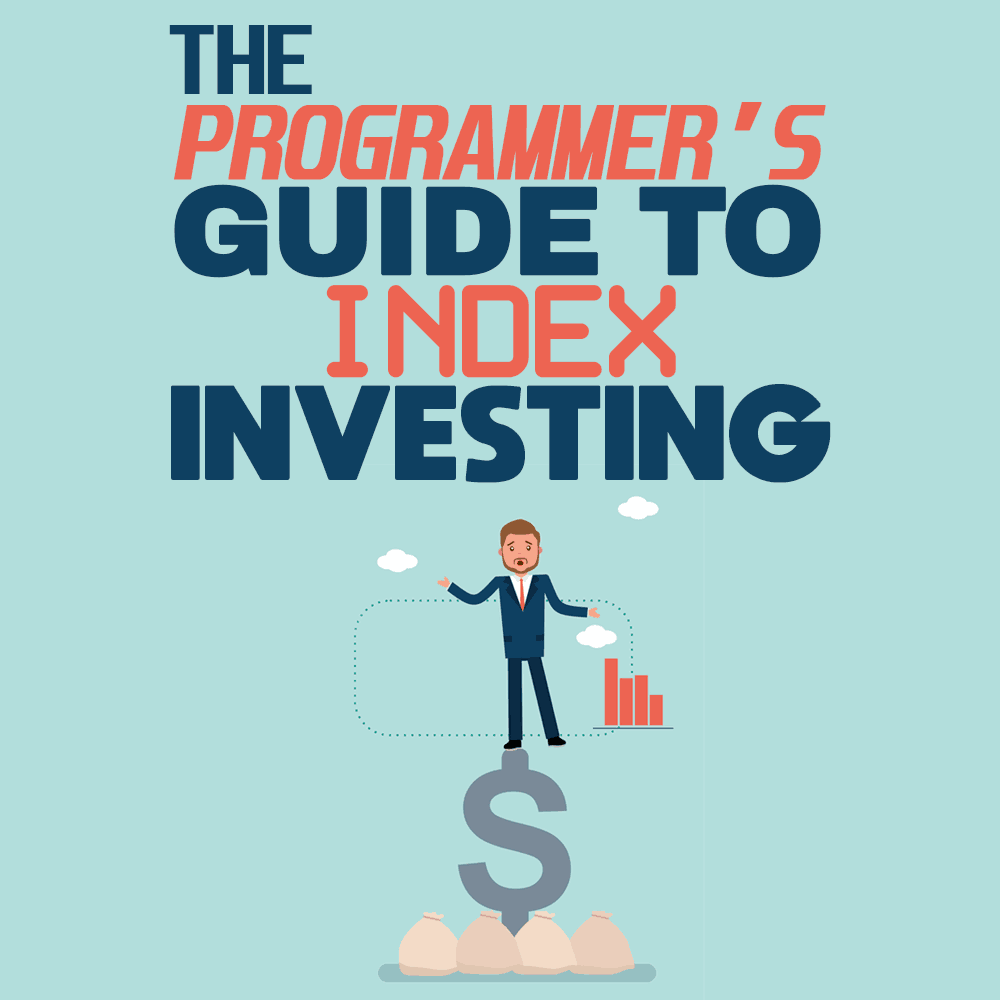
First, programmers make above-average income. According to US News, the average salary of a programmer is about $85,000. That’s well above the general average salary in the United States of about $56,000. It’s 51.8% higher, to be exact.
Second, programmers typically work more than a 40-hour work week. A high-paying job usually comes with some increased demand as well, and for programmers it’s no different.
These two facts, being high in income and low on time, make index investing a compatible investment strategy for programmers. In this post I’ll show you how programmers can start index investing the right way.
In these volatile times, where programming jobs come and go as quickly as the startups that created them, having a solid investment plan can be crucial for your career.
What is Index Investing?
The first index fund was created by John Bogle, the founder of Vanguard.
He took two relatively popular concepts at the time, mutual funds and indexes, and combined them. It may not seem like much, but it completely revolutionized the investing world.
An index, in its most basic form, is just a measure of something. Financially speaking, an index is used to measure a group of assets, like stocks or bonds. Examples of indexes include the Dow Jones Industrial Average and the S&P 500.
A mutual fund is an investment vehicle that combines multiple investor’s funds together to purchase a larger, diversified group of assets.
For example, say you have 100 investors that all want to create a diversified investment portfolio. They could all go out and buy 100 individual stocks (10,000 total transactions), but that is costly and takes a lot of time. Instead, they can pool their money together in a mutual fund, and the fund buys the 100 individual stocks on their behalf.
An index fund combines the two concepts. An index fund is a mutual fund, except instead of having a manager pick the 100 stocks to invest the collective funds in, the funds are invested in an index.
If Microsoft makes up 3% of the S&P 500, 3% of the money within the index fund gets invested in Microsoft stock (with an S&P 500 index fund). An active manager does not get to put 20% in Microsoft because they have a hunch. The index fund mirrors the index—no exceptions.
It’s a great way to “buy the US stock market,” or any other index, with one easy investment.
Why Index Investing Works for Programmers
As mentioned, programmers in general are higher in income and low on time.
With a high income, you could put your extra cash into a savings account or other bank product, but the best way to plan for retirement is to invest it. Investing in a combination of stocks and bonds has provided the best returns over the long-term compared to other, more conservative options.
Since programmers are low on free time, they likely don’t want to spend it constantly researching stocks and reallocating funds between them. Index investing is a super simple form of investing that does not take a lot of time to set up or manage.
In fact, there are a few major benefits of index investing that programmers should be aware of:
- Simplicity: Index investing is a very simple form of investing. It’s largely a “set-it-and-forget-it” strategy that just takes a few hours to set up.
- Low-cost: The fees on index funds can be very small (when you choose the best index funds) compared to actively managed mutual funds. This means more money in your pocket at the end of the day..
- Quick Diversification: Investing in index funds allows you to diversify across hundreds (usually thousands) of assets with just one purchase. This eliminates the need to research and purchase hundreds of stocks.
Don’t just take it from me though. Warren Buffet, one of the most renowned investors in the world, is a fan of index investing as well.
As he told CNBC, “Consistently buy an S&P 500 low-cost index fund… I think it’s the thing that makes the most sense practically all of the time.”
How to Start Investing in Index Funds

Below is your quick guide on how to get started, which involves three simple steps:
- Determine Where to Invest
- Research and Select Your Funds
- Monitor Ongoing
Let’s take a look at them one by one.
Determine Where to Invest
The first step in determining where to invest is to select the type of investment account to invest in. The most common options you have are:
- Personal Brokerage Account
- Individual Retirement Account (IRA)
- Roth IRA
- Traditional IRA
- 401(k)
This is not an exhaustive list by any means, but they are your top options for getting started.
Typically, investing in your retirement accounts (IRAs and 401k) is the better place to start. You’ll have less flexibility with money, but they offer huge tax breaks which are worth taking advantage of. You don’t necessarily have to max them out either, but you should be making at least some contributions.
In 2020, the max contributions for your retirement accounts are:
- IRA: $6,000
- 401(k): $19,500
A personal brokerage account is your most flexible option, but you won’t get any tax incentives with this account.
Once you have selected the investment account(s) you want to invest in, you need to decide which online broker you will invest through.
The one exception is with 401(k)s, where you are likely limited to whatever broker your employer has chosen.
However, with a personal brokerage account or IRA, you can choose between a seemingly endless number of online brokers, however my 3 favorites are:
- Charles Schwab
- Vanguard
- Fidelity
The key is to pick a reputable broker who has a wide selection of low-cost index funds for you to choose from.
You could also consider a robo-advisor, like Betterment, who is an online broker that will manage your account for you. Although, robo-advisors do come with higher fees attached to them.
Research and Select Your Funds
Once you know where you will invest, it’s time to research and select and your funds. There are three major things I look for when picking an index fund:
- What Index to Mirror: The first step in picking an index fund is determining what index you want to mirror. You have a ton of choices, including bond indexes, small-cap indexes, international equity indexes, and just your standard S&P 500 index, among many others.
- The Fees: There are a few fees associated with index funds, but the main one is the expense ratio. The expense ratio on an index fund should always be below 0.25% in my opinion. However, you can find expense ratios as low as 0.03%, and with Fidelity a few are even 0%!
- Distribution Yield: The last thing I check is the distribution yield, which is the fixed income (or dividends) that the fund pays out on a percentage basis.
One of my personal favorite strategies for starting an index portfolio is to create a 3 fund portfolio. This involves buying 3 index funds:
- Domestic equity index fund
- International equity index fund
- Bond market index fund
And then allocating your capital between the three funds depending on your risk tolerance and proximity to retirement.
Monitor Ongoing
Last but not least, you need to monitor your investment portfolio ongoing.
To be clear, you should not be looking at your investments every day. Or, at least try not to. This is a great way to turn a simple thing into something complicated.
However, on a monthly, quarterly, or annual basis, you should be checking in on your investments to add more funds and rebalance as needed. Consider using some automation best-practices to set up alerts and automatic transfers to make this part of the process as seamless as possible.
What to Consider Before Investing
Investing is a long-term strategy. It should be to prepare for retirement or for goals that are more than 5 years away.
You should not be using short-term money for long-term investments!
Here are a few things to consider doing before starting your index investing journey.
Pay Off Debt
Specifically, pay off any high-interest debt. The interest on “bad” debt like credit cards is typically higher than the average returns you can expect from investing, so it makes sense to pay that debt off before you start investing.
However, forms of “good debt” like student loans and mortgages can sometimes have lower interest rates (5% or lower). If that’s the case, taking a balanced approach between paying off debt and investing is usually a wise choice.
Build an Emergency Fund
Most experts recommend having at least 3-6 months of savings on hand in a bank account for emergencies.
You could have more, or less. It all depends on how risky you’re current lifestyle is:
- Job security
- General health
- Number of assets that could need repair (car, house, etc.)
- And more…
It is something to consider before diving right into investing.
Create a Budget
Last, you should have a budget.
Mainly because getting this down on paper can help you understand how much money you will have leftover each month to invest. And, if it’s less than you thought, you can make a plan to increase that number by either increasing your income or lowering some of your expenses.
Index Investing Is a Great Strategy

Anyone can get started by following these three simple steps:
- Determine Where to Invest
- Research and Select Your Funds
- Monitor Ongoing
Starting to invest can be just as important, if not more, than negotiating a salary or buying a house over the long run. So there is no excuse to not start today!
This article is not intended to be official investment, tax, financial or legal advice. Investors should always seek professional advice for their particular situation.
